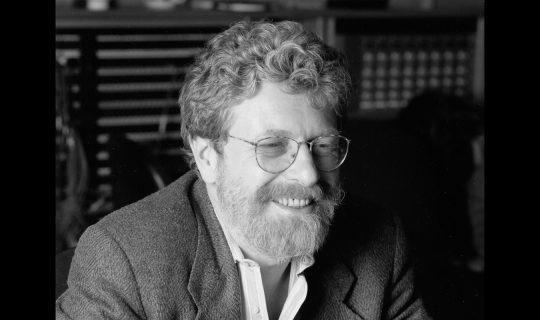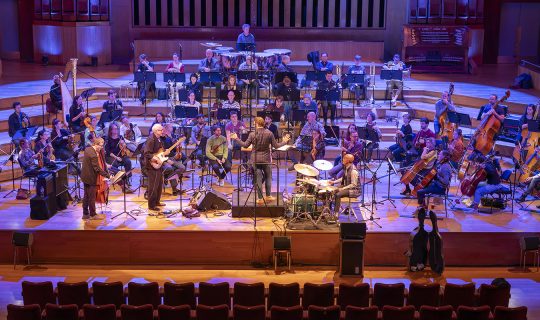June 12, 2015
Primal subversion of the most delicious kind was in the air when alto saxophonist Ornette Coleman introduced his latest chapter of “the new jazz” in December 1965 at Stockholm’s Golden Circle (Gyllene Cirkeln) club. In tow was the trio he had been exploring new soundscapes with in the past year: virtuoso bassist David Izenzon, equally adept playing arco and pizzicato, and simpatico drummer Charles Moffett, shining with his textured cymbals and spanking rimshots.
At the Golden Circle on December 3 and 4, Blue Note recorded two live volumes of the threesome breaking new ground, marking the label’s first association with the iconoclastic saxophonist who had turned the jazz world upside down six years earlier with his debut 1959 album for Atlantic, The Shape of Jazz to Come. While that album and live performances on both coasts initially met with polar critiques ranging from genius to derision, Coleman, more than any other far-reaching, cutting-edge artist, proved to be the bellwether of the next evolutionary stage of jazz. Even though he was the epitome of the avant-garde then, today his renegade music of the late ‘50s and early ‘60s sounds remarkably modern—especially since a plethora of musicians over the years have taken his lead and play music today that is more in sync with what was once considered to be so scornfully radical.
Significantly, previous to his six-album Blue Note stint, Coleman had pulled a Sonny Rollins-type sabbatical from the jazz scene, a self-imposed exile from performing and recording, from December 1962 (after a self-produced concert at Town Hall in New York) to January 1965 (a triumphant return at the Village Vanguard where he added trumpet and violin to his instrumental arsenal). He reemerged refreshed and teeming with imagination.
On At the Golden Circle, Volume One, Ornette and Co. are in topdrawer form. Writing in the liner notes of the 2002 Blue Note RVG CD reissue of the album, John Litweiler, author of the book Ornette Coleman: A Harmolodic Life, calls the album “extraordinary,” adding that “the sheer creativity of Ornette Coleman’s improvising here would be miraculous at any time in jazz history; moreover, even by his own high standards, he made some of the finest music of his recording career at the Golden Circle.” Comprising four Coleman originals, Volume One opens with the emcee introducing the trio and Ornette shyly replying, “We’ve so enjoyed ourselves here and hope everyone else has also.” He then whips into the brisk dance “Faces and Places,” which features his ebullient alto whimsy. It’s an expansive song of joy, taken at bop speed, flowing with a bouncy lyricism and heightened by his high-pitched wails. Coleman’s improvisational enthusiasm continues on “European Echoes,” a track of simultaneous group improvisations that starts off as an off-kilter waltz. He toots the tune in a catchy—and unusual—calliope-like style.
Fast-paced, happy-go-lucky “Dee Dee” has a sometimes-it’s-there-and-sometimes-it’s-not angular swing that serves as an unsteady undergirding and features Coleman as melody maker par excellence (with stretches of bright dissonance and a few funny alto-fed false endings). The “ballad” of the session is “Dawn,” which is in pockets dreamy, emotional and anguished. Of special note is the interplay between Izenzon bowing his bass with both an edginess and a classical music-like beauty and Coleman in alto search mode joining him harmonically and conversationally after his solo.
Volume Two starts out sounding like a hoedown as Coleman rips open “Snowflakes & Sunshine” with his blazing fiddle, which quickly dips into dissonance as he scratches and squeals while Izenzon and Moffett jump into the frolic. Izenzon—who started to play the double bass at age 24, quickly became an avant favorite particularly with Coleman from 1961- 68 and then died at the age of 47 in 1979—hypercharges the affair with his bowed bass responding to Coleman’s violin. Then the leader introduces the trumpet, which he plays high-speed and flailing. He goes back and forth between the two instruments throughout the tune.
Coleman returns to the alto saxophone the rest of the set on the lyrical ballad “Morning Song” (his yearning voice joined by Izenzon’s deep-bowing discord), the fast and frenzied “The Riddle” (with noteworthy alto-drum interaction) and easy-going “Antiques” (with Coleman cruising with some of his best off-kilter lyricism).
Both volumes of At the Golden Circle demonstrate so brilliantly how elated Coleman instinctually expressed his music. There’s no froth here, no boasting, no artifice—but vital, heartfelt lyricism by a man on a mission to heed his own voice and as a result further distance himself from the status quo. To be one’s self, after all, is the embodiment of art. That was Ornette’s story throughout his life, but especially manifest in these astonishing concerts—a special snapshot capturing both his care and his impulse.








